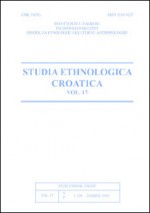Propitivanje religijskog identiteta na primjeru Istre
Some Aspects of Religious Identity in Istria
Author(s): Marijana BelajContributor(s): Tanja Bukovčan Žufika (Translator)
Subject(s): Christian Theology and Religion, Cultural Anthropology / Ethnology, Identity of Collectives
Published by: Sveučilište u Zagrebu, Filozofski fakultet
Keywords: religious identity; Istria; patron saints; ethnology of religion; ethnic identity;
Summary/Abstract: Religious identity is multi-layered and changeable as any other identity; it carries multiple meanings and it is in constant interaction with other identities. Additionally, its content highly depends on our standpoint. Religious identity in Croatian social sciences is discussed only as source of signs and symbols, and from the standpoint of formation of ethnic identities. However, it seems that only specific and highly specialized circumstances have an important role in linking religion to ethnicity. Focusing on a region where religion is, among other things, the differentiating characteristic between the two ethnic groups, can be very rewarding (Čimić 1984:33), but it cannot completely determine the religious factors which influence the formation of ethnic identity. (It is important to emphasize that the religious identity in a region, such as Istria, where one religion is dominant is something quite different that in regions where this is not the case). This article is trying to show deeper and more complex aspects and meanings of the term religious identity, and point to its position, meaning and role, both for individual members of a given culture and for the community. It is also trying to include another standpoint in the analysis of the religious identity and that is the standpoint of the religion itself, or, in other words, from the Christian point of view, which, according to the data obtained during the field work and the data found in literature, proved to be equally important. Examples used in this article are taken from the interviews and field notes obtained during field research on patron saints. Interviewees almost always start with the patron saints of their own village or their own church, and patron saints which they can see on their church altars or whose sites of pilgrimage are situated near-by. When talking about their local patron saints, they commonly use terms such as 'our patron', 'we have' (processions, saints and so on) etc., as opposed to 'their patron', 'they have' and so on, when talking about their neighbors' saints. What they know about the local and other saints is basically public knowledge, but these accounts also contain expressions of individual religious feelings. The next step in discussing the saints are the individual stories of one or more of them, who are present in their everyday life, whom they address in their prayers, and whom they chose according to their own personal preferences. The chosen saint is referred to as a friend for life, as a personal guardian, and his help is asked in different real-life situations, and not only in those which are covered by public knowledge. This last account, according to the author, is direct and important illustration of dedicated personal creed, which is the basic characteristic of Catholic identity. The term religious identity, according to the examples, is very complicated and almost impossible to define according to some pre-set principles and 'big theories'. However, if we start at the bottom (narrower meaning) and move towards the top (towards wider meanings), we can notice the following: According to the examples, religious identity can be linked to ethnic and local identities, to social, political and economic system, to history, etc. But I am trying to point out that the element which is continually present in all these relations is personal religion and personal relationship with God. Personal creed, therefore, presents the basis of Christian (here, catholic) identity, and the Christian view of the world, and it is, above all, as it is stated in the literature, the core meaning of Christianity as such. Hence, religious identity should be, in the first instance, examined primarily as personal creed of every individual. Furthermore, only after we define and examine the religious identity in that way, we can examine its role in the formation of cultural, political or social identity. Namely, individual faith exists independently, and needs no form. But even though it is embedded in individual life, personal creed is more powerful if performed in a group (it is believed that communal prayer holds greater power); it has to be, in a way, codified and materialized in, for example, a prayer to a particular saint, to a saintly statue, on a mass, procession etc. Only here we can examine the signs through which the religion is materialized as the symbols of a particular group, which is centered on them and for which these symbols carry different meanings, some of them moving into the realm of profane.
Journal: Studia ethnologica Croatica
- Issue Year: 2003
- Issue No: 14/15
- Page Range: 55-68
- Page Count: 14
- Language: Croatian

